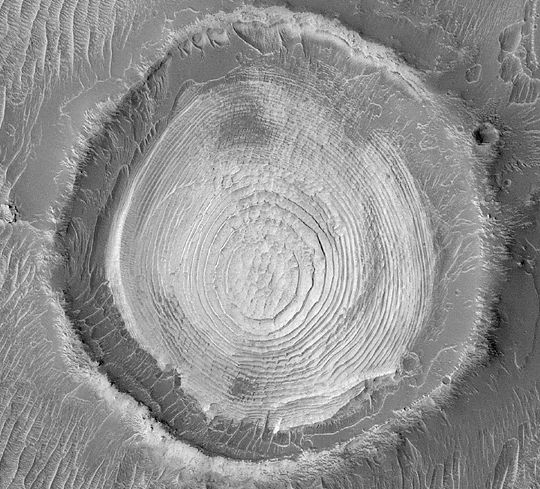Explanation: High-resolution imaging of an area in the Schiaparelli Basin of Mars on June 3 by the MGS Mars Orbiter camera produced this stunning example of layered formations within an old impact crater. On planet Earth, such structures would be seen in sedimentary rock -- material deposited at the bottom of ancient lakes or oceans and then subsequently weathered away to reveal the layers. With the Sun shining from the left, the central layer appears to stand above the others within the 2.3 kilometer wide crater. The crater could well have been filled with water in Mars' distant past, perhaps resting at the the bottom of a lake filling the Schiaparelli impact basin. Still, such layers might also have been formed by material settling out of the windy martian atmosphere. As satellites continue to examine the martian surface from orbit, NASA's Spirit and Opportunity spacecraft will attempt to land on on Mars early next year to further explore the tantalizing history of water on the Red Planet.
1999 2000 2001 2002 2003 2004 2005 2006 2007 2008 2009 2010 2011 2012 2013 2014 2015 2016 2017 2018 2019 2020 2021 2022 2023 2024 2025 |
Yanvar' Fevral' Mart Aprel' Mai Iyun' Iyul' Avgust Sentyabr' Oktyabr' Noyabr' Dekabr' |
NASA Web Site Statements, Warnings, and Disclaimers
NASA Official: Jay Norris. Specific rights apply.
A service of: LHEA at NASA / GSFC
& Michigan Tech. U.
|
Publikacii s klyuchevymi slovami:
Mars - crater - sedimentary rock - Mars - krater - osadochnye porody
Publikacii so slovami: Mars - crater - sedimentary rock - Mars - krater - osadochnye porody | |
Sm. takzhe:
Vse publikacii na tu zhe temu >> | |
